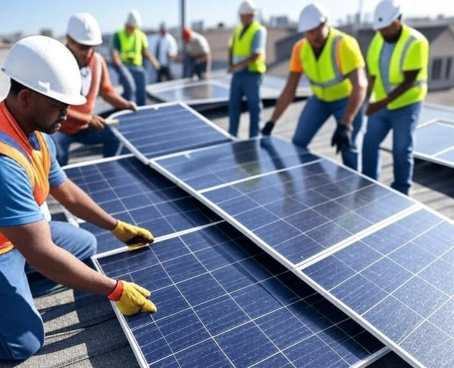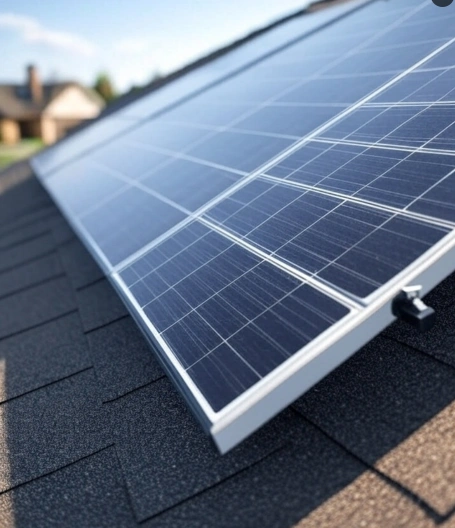
As global demand for renewable energy continues to grow, solar power has gained widespread attention in the United States as a clean, sustainable energy source. In recent years, declining solar panel costs, government incentives, and technological advancements have made solar systems increasingly attractive to households and businesses. However, installation costs vary due to factors such as region, system size, and installation complexity. This article will detail the average cost of solar panels in the U.S. in 2025, factors influencing costs, potential savings strategies, and provide a forecast for 2026–2028.
Based on the latest 2025 market data, the average installation cost for a residential solar system in the U.S. ranges from $20,000 to $36,000, depending on system size, geographic location, and installation requirements. Below are key data points:
Cost per Watt:
According to EnergySage and the Solar Energy Industries Association (SEIA), the average cost for residential solar systems in 2025 is approximately $2.56 to $3.62 per watt (pre-installation, before tax credits). For example, a typical 11-kilowatt (kW) system costs about $28,160 to $39,820, with net costs dropping to $19,712 to $27,874 after applying the 30% federal tax credit.
System Size:
The average U.S. household requires a solar system sized between 7 and 11 kilowatts, depending on electricity consumption. For instance, in hot regions like Arizona, larger systems may be needed to meet high energy demands (e.g., air conditioning), while colder regions like Maine may require smaller systems.
Cost per Solar Panel:
Based on 2025 survey data, the average price for a single professionally installed solar panel is around $1,200. A complete residential system typically requires 20 to 30 panels, resulting in total costs of $24,000 to $36,000.
Impact of Incentives:
The federal Investment Tax Credit (ITC) in 2025 provides a 30% tax credit, significantly reducing installation costs. For example, a $30,000 system’s net cost can drop to $21,000 after the credit. Additionally, many states offer further rebates or tax incentives, such as up to $5,000 in subsidies for residential installations in certain states.
Solar panel costs are influenced by multiple factors. Below is an analysis of the primary factors: System Size and Type:
System size is a key determinant of cost. Larger systems (e.g., 20 kW) have higher total costs but lower per-watt costs (similar to bulk purchase discounts). Additionally, the type of solar panel impacts costs:
Monocrystalline Panels: Highest efficiency (15%–22%), ideal for homes with limited roof space, but more expensive.
Polycrystalline Panels: Slightly lower efficiency (13%–17%), more affordable, suitable for budget-conscious households.
Geographic Location:
Labor costs, permitting fees, and grid connection requirements vary by region. For example, California has the lowest average per-watt costs, while West Virginia and Alabama have higher costs. Urban areas typically have higher installation costs than rural areas due to stricter building codes and elevated labor rates.
Installation Complexity:
Roof type (e.g., tile or metal), roof pitch, and layout affect installation difficulty. Complex roofs may require additional equipment or structural reinforcements, increasing costs.
Tariffs and Supply Chain Issues:
In 2025, the solar industry is impacted by new tariff policies. The U.S. imposes countervailing duties on crystalline silicon cells and panels imported from Vietnam, Malaysia, Thailand, and Cambodia, with rates ranging from 0% to 300%, leading to an average hardware cost increase of 10 cents per watt. While domestic manufacturing is growing, reliance on imported components may drive short-term cost increases.
Additional Equipment:
Adding energy storage systems (e.g., batteries), inverters, or smart monitoring systems significantly raises total costs. For instance, a home energy storage system can cost between $5,000 and $15,000, depending on brand and capacity.
Despite the high initial investment, solar systems offer substantial long-term savings, making them an attractive investment. Key points include:
Electricity Bill Savings:
2025 surveys indicate that households with solar systems save an average of $196 per month on electricity bills (based on 14 panels, saving approximately $14 per panel). As utility electricity rates continue to rise (from 5 cents per kWh 45 years ago to 18 cents today), the return on investment (ROI) for solar systems becomes even more compelling.
Payback Period:
The average payback period for residential solar systems in the U.S. is about 7 to 10 years. With a system lifespan of 25 to 30 years, the remaining years provide essentially “free” energy, significantly reducing household energy costs.
Environmental Benefits:
Solar systems reduce reliance on fossil fuels, substantially lowering carbon footprints. According to the U.S. Energy Information Administration (EIA), solar power is expected to account for 58% of new U.S. electricity capacity additions by 2025, contributing significantly to energy independence and sustainability goals.
Based on current trends, technological advancements, and policy changes, below is a forecast for U.S. solar panel costs from 2026 to 2028:
Continued Cost Declines:
Over the past decade, solar photovoltaic (PV) panel costs have dropped by more than 80%, and further reductions are expected by 2028. Technological advancements, such as perovskite solar cells and bifacial panels, will improve efficiency and lower production costs. Experts predict that by 2028, solar module prices could approach $0.10 per watt, several years ahead of 2023 projections.
2026: Per-watt costs are expected to fall to $2.30 to $3.30, with an 11 kW system costing approximately $25,300 to $36,300, or $17,710 to $25,410 after tax credits.
2027: As manufacturing scales and energy storage technology advances, per-watt costs may drop to $2.10 to $3.10, with system costs around $23,100 to $34,100.
2028: Per-watt costs are projected to stabilize at $2.00 to $3.00, with system costs of $22,000 to $33,000, or $15,400 to $23,100 after credits.
Policy Uncertainty:
In 2025, the federal Investment Tax Credit (ITC) faces the risk of expiration, which would significantly impact net costs. If the ITC ends after 2026, consumers may rely on state-level incentives or new financing models (e.g., zero-down solar loans) to reduce upfront costs. Additionally, new administration trade policies, such as additional tariffs on imported solar components, may increase short-term costs, though growth in domestic manufacturing will partially offset this impact.
Technological Advancements:
Commercialization of perovskite solar cells and tandem solar cells is expected to accelerate between 2026 and 2028. These technologies could boost efficiency to over 30%, reducing the number of panels needed and lowering system costs. Furthermore, integration of artificial intelligence (AI) and the Internet of Things (IoT) will optimize energy management and maintenance, enhancing ROI.
Energy Storage Adoption:
With breakthroughs in battery technology, energy storage system costs are projected to decline by 20–30% from 2026 to 2028. This will make solar-plus-storage solutions more attractive, particularly driven by high-energy sectors like data centers and AI.
Regional Variations:
Cost reductions will vary by region. Sun-rich states like Texas, Florida, and Arizona will continue to benefit from lower per-watt costs, while the Northeast and Midwest may see higher prices due to elevated labor costs and fewer state incentives.
To minimize the upfront cost of solar systems, consumers can take the following steps:
Compare Multiple Quotes:
Use platforms like EnergySage or Solar.com to obtain quotes from multiple installers, ensuring the most competitive pricing.
Leverage Incentives:
Beyond the federal ITC, check for state and local rebates. For example, California and Massachusetts offer additional solar subsidies.
Choose High-Efficiency Panels:
Invest in high-efficiency monocrystalline or emerging perovskite panels. While upfront costs are higher, they reduce the number of panels needed, lowering long-term costs.
Consider Community Solar:
For households unable to install solar on their roofs, community solar programs allow subscription to nearby solar arrays, providing bill credits without upfront investment.
Financing Options:
Zero-down solar loans and leasing programs are increasingly common in 2025, helping consumers spread costs while starting to save on electricity bills immediately.
In 2025, the average installation cost for solar panels in the U.S. ranges from $20,000 to $36,000, with net costs significantly reduced by federal and state incentives. Factors influencing costs include system size, geographic location, installation complexity, and tariff policies. Looking ahead to 2026–2028, technological advancements and economies of scale are expected to drive costs further down, with per-watt costs potentially as low as $2.00 to $3.00, while the adoption of energy storage systems will enhance solar’s appeal. However, policy uncertainties, such as the potential expiration of tax credits and tariffs, may pose short-term challenges.
For households and businesses considering solar investment, now is an opportune time to act. Leveraging current incentives, comparing quotes, and selecting efficient technologies will maximize long-term savings and environmental benefits. As the solar industry continues to evolve rapidly, the U.S. is moving toward a cleaner, more independent energy future.





